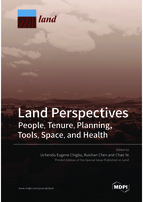Land Perspectives: People, Tenure, Planning, Tools, Space, and Health
A special issue of Land (ISSN 2073-445X). This special issue belongs to the section "Land Socio-Economic and Political Issues".
Deadline for manuscript submissions: closed (30 November 2021) | Viewed by 60602
Special Issue Editors
Interests: gender; land use planning; governance and administration
Special Issues, Collections and Topics in MDPI journals
Interests: land use change, natural resource management, land use planning, environmental governance; rural-–urban interaction, social justice; disaster risk reduction; extreme events; sustainable development goals
Special Issues, Collections and Topics in MDPI journals
Interests: environment governance; production of space; land use and management; rural-urban interactions; sustainable development goals; gender issues; inequality
Special Issues, Collections and Topics in MDPI journals
Special Issue Information
Dear Colleagues,
Efficient land (including water and forest) administration practices are required to achieve many global development agendas—e.g., land degradation neutrality, New Urban Agenda, COP21, Sustainable Development Goals (SDGs), and COVID-19 or Coronavirus pandemic challenges. It also helps to create a peaceful environment by eliminating social conflicts caused by poor land administration practices. Achieving these agendas requires an understanding of how land administration practices can impact people, property tenure, and health or wellbeing. Hence, there is a need to probe natural resources administration theories and tools.
Good land administration helps to secure property tenures. It also protects the land rights of people (including individuals, communities, and the state) through good governance principles and practices. Therefore, probing land administration practices—whether in developed or developing countries—is essential to developing tools or methods for securing natural resource rights for people, especially for youth and women. Understanding the land and health or wellbeing nexus is crucial for adequate living conditions for people in living urban, peri-urban, and rural areas. A broad knowledge gap exists on the land/water/forest–people–health–wellbeing nexus of natural resource administration research and practical tools.
This Special Issue presents insights on theories and practices on land administration in the context of land/water/forest–people–health–wellbeing nexus relationships. We, therefore, invite conceptual, case studies, field research, and review articles focusing on (but not limited to) the following themes:
- Land administration and property sciences.
- Urban and peri-urban land/water/forest administration.
- Rural land administration.
- Land/water/forest administration (including governance, policy, and management) approaches and their impacts on people’s wellbeing.
- Administering land and natural resources to ensure social equity in developing countries.
- Social conflicts related to land, water, forest, and other natural resources.
- Consequences of COVID-19 or coronavirus for the global agenda on land and the environment.
- Land administration in the context of women and youth land rights.
- Spatial, regional and territorial planning.
- Urban-rural land linkages.
- Land tools for global change and local action.
- Land/water/forest–people–health interconnectivity.
- Responsible governance of tenure and societal transformations.
- Tenure security and public health relations in human settlements.
- Cases of land and health situations in the Global North and South.
- Impact of pandemics on people’s land rights with a focus on progress so far.
- Behavioral and social changes needed for the promotion of tenure security and healthy environmental situations; and
- Emerging approaches to land administration challenges going forward.
Prof. Dr. Uchendu Eugene Chigbu
Prof. Dr. Ruishan Chen
Prof. Dr. Chao Ye
Guest Editors
Manuscript Submission Information
Manuscripts should be submitted online at www.mdpi.com by registering and logging in to this website. Once you are registered, click here to go to the submission form. Manuscripts can be submitted until the deadline. All submissions that pass pre-check are peer-reviewed. Accepted papers will be published continuously in the journal (as soon as accepted) and will be listed together on the special issue website. Research articles, review articles as well as short communications are invited. For planned papers, a title and short abstract (about 100 words) can be sent to the Editorial Office for announcement on this website.
Submitted manuscripts should not have been published previously, nor be under consideration for publication elsewhere (except conference proceedings papers). All manuscripts are thoroughly refereed through a single-blind peer-review process. A guide for authors and other relevant information for submission of manuscripts is available on the Instructions for Authors page. Land is an international peer-reviewed open access monthly journal published by MDPI.
Please visit the Instructions for Authors page before submitting a manuscript. The Article Processing Charge (APC) for publication in this open access journal is 2600 CHF (Swiss Francs). Submitted papers should be well formatted and use good English. Authors may use MDPI's English editing service prior to publication or during author revisions.
Keywords
- COVID-19 and land
- health
- land administration
- land/water/forest governance
- land management
- land policy
- land tenure
- land tools
- natural resources
- people
- planning
- property
- space
- wellbeing
- women’s land rights
- youth
Related Special Issues
- Land Tenure and Spatial Functions in the Living Conditions of People in a Global World in Land (6 articles)
- Land, Women, Youths, and Land Tools or Methods in Land (15 articles)








